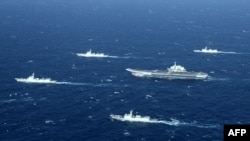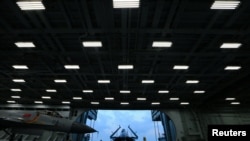A Chinese navy ship stayed in the Sulu Sea southwest of the Philippines for three days, upsetting Manila. Experts say it is a part of Beijing’s effort to look after its interests in an ever-wider swath of the world's waterways.
A People’s Liberation Army-Navy vessel worked the Sulu Sea from January 29 to February 1; according to a Monday statement from the Department of Foreign Affairs in Manila, this was an “illegal incursion.”
The Electronic Reconnaissance Ship No. 792 “entered Philippine waters without permission” and stayed even after a Philippine navy ship challenged it, the statement says.
At a March 15 news conference, Chinese Foreign Ministry spokesman Zhao Lijian said the navy research vessel had carried out “an exercise of the right of innocent passage pursuant to UNCLOS [United Nations Convention on the Law of the Sea]. The Chinese passage was safe and standard, and consistent with international law and international practice.”
The Chinese side’s comment showed no immediate intent to do more in the Sulu Sea, said Herman Kraft, a political science professor at University of the Philippines Diliman.
“Talking about innocent passage seems to be an excuse that recognizes Philippine jurisdiction over the area,” Kraft told VOA.
Sulu Sea significance
Beijing is trying to expand the reach of its growing navy to protect its maritime interests and increase bargaining power in talks with other countries, analysts have told VOA. Chinese navy ships have been spotted from the Indian Ocean to the Pacific east of Taiwan and Japan.
A naval visit to the Sulu Sea could mean Beijing wants to establish a presence in waters closer to Indonesia and Australia while buffering its South China Sea claims, analysts suggest.
“This could be China exploring a third access to Pacific, after Miyako and Bashi straits,” said Yun Sun, co-director of the East Asia program at the Stimson Center in Washington. The two straits are near Taiwan. “The U.S. apparently uses it often, so the Chinese might feel it could do the same,” Sun said.
China has protested U.S. naval presence in Asia and has said that Washington is trying to check Chinese expansion.
The People's Liberation Army-Navy now has the ability to “operate military assets” as far off as Djibouti, said Alexander Vuving, a professor at the Daniel K. Inouye Asia-Pacific Center for Security Studies, in Hawaii. Like the United States, he said, China is free under international law to sail on the high seas, which are waters unclaimed by other nations.
“The strategic perspective is that Chinese naval capability is growing, so China sooner or later will send out its warships to areas outside of the first island chain and even outside the second island chain,” Vuving said. The first chain refers to the band from Russia’s Kirul Islands south to Borneo. The second includes Papua New Guinea, the Marianas and the Caroline Islands.
China’s former President Hu Jintao called in 2012 for China to become a “maritime power.” President Xi Jinping, in 2018, said it was urgent that China build a “powerful navy.” A year later, the country’s defense white paper said China needed to carry out “missions on the far seas.”
“China’s navy is viewed as posing a major challenge to the U.S. Navy’s ability to achieve and maintain wartime control of blue-water ocean areas in the Western Pacific – the first such challenge the U.S. Navy has faced since the end of the Cold War,” the U.S. Congressional Research Service said in a March 8 research note.
The Chinese military may be exploring the Sulu Sea as a detour in or out of the adjoining South China Sea in case of any conflict, Vuving said. Warships could use the Sulu Sea to launch vessels into the South China Sea or seal it off, he said.
Beijing claims most of the South China Sea. It has upset the Philippines and four other Asian governments that claim all or part of the same resource-rich, 3.5 million-square-kilometer waterway. China, backed by military and technological superiority, is building out once-uninhabited islets for hangars, radars and tiny outposts. U.S. warships periodically enter the sea as warnings to China.
As of 2012, the Chinese navy had 512 ships, according to Britain’s International Institute of Strategic Studies. It now has 777 assets, mainly seafaring vessels, the database Globalfirepower.com says.












